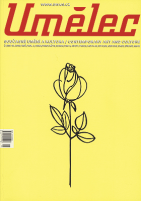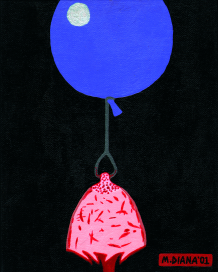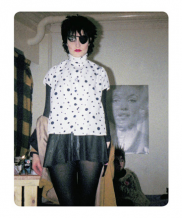| Umělec magazine 2000/4 >> A Space Expedition & Laboratory Experiments | List of all editions. | ||||||||||||
|
|||||||||||||
A Space Expedition & Laboratory ExperimentsUmělec magazine 2000/401.04.2000 Holger Emil Bange | artist | en cs |
|||||||||||||
|
"When I first saw Max Mohr’s objects in 1992 in the Museum of Modern Art in Frankfurt, I was attracted and repelled at the same time. I was confused but they gripped me; I was excited but I felt like I should be careful. I had never seen absurd forms and materials like these in art, and all I could feel was respect. At first I wasn’t sure how to appreciate the works, but they soon drew me into more closely observing them. This kind of expression was just too fascinating for me. I developed a number of associations that had to be as is replayed. After I met the artist in person a few years later and we had become friends, I finally had the thrill of directly touching the pieces. Something like this is impossible in a museum!
Mohr (1962) has remained faithful to his materials and forms to this day without repeating himself or ceasing to evolve. In Mohr’s art the material—the subject of constantly new variations—was the essence of the work made during his studies and before. When he came to the Städel Art Academy in Frankfurt in 1982 “die Wilden” were the IN thing. But Mohr was already part of the next generation lost in search of a solution to painting. Starting off with drawings, Mohr progressed to experiments with performance (exclusively in the non-public space of the Academy), moved on to working with a computer and then finally he began working with objects. In 3-D software on Silicon Graphics machines, he performed shaping processes and in fact made his first objects in this totally synthetic world. This created the desire to make artifacts that possessed the same “perverse smoothness and lubricity” (Mohr) as industrial products but which would be handmade. He was looking for materials with the same synthetic quality as computer images. In the end only by chance did he find the peculiar material so standard for him now. He stumbled across this material, used for making replacement body parts, in an orthopedic workshop dump. He went to buy more, and once inside the workshop he witnessed for himself the incredible flexibility of the material. This corresponded with his intention to imitate the polymorphous—or, as Mohr says, androgynous—forms made in the computer. Mohr could now leave the sterile environment of the computer and penetrate into 3-D, putting shape to his ideas. His performances, using changes in clothing, were about metamorphoses symbolizing pupation. Through his working methods his objects typically went through a certain process of growth. He is often lead by spontaneous, unbridled behavior, which influences the appearance of the objects in a significant and unpredictable way. It is a certain organic evolution; the idea matures throughout the course of the work and may shift in a completely different direction at any moment. With a few exceptions (Georg Herold, Marcel Duchamp) visual art as an influence is rather secondary for Mohr. Before his university studies, he was a musician and he continues to play music. He played in various punk and new wave bands in the Frankfurt scene. He is currently recording electronic music under his own name. Pop culture has been more important to him than visual art from the very beginning. In the 1970s and 1980s he followed the bands that were partly involved in the art scene and that proposed all-encompassing concepts and, as Mohr says: “envisaged the entire man.” Mohr’s method of working music shows significant parallels with how he works in visual art. In both he uses found material, which, like a hunter, he tracks down. He breaks up the material and then pieces it back together again, blending it with his own work. Examples include: a captured echo from under a bridge, the sound of an accordion player in a pedestrian zone, a piece of plastic found in the street, a polyester sweater from a flea market. Some are turned into pop-house compositions and electronic music while industrial (waste) products are used to complement or break up his pastel-colored objects. Mohr draws inspiration for his forms from a variety of fields. He was like a wide-eyed child dazzled at the end of the 1960s by the omnipresent space research and the related science fiction films and books. But he is also interested in the natural sciences and astronomy, and he gets into biology, microbiology, physics, and chemistry. Hence his biomorphic, polymorphic and amorphous forms, reminiscent indeed of unknown worlds and laboratory experiments. Last but not least, everyday impressions influence his art, everything from a glass counter in a sushi bar to the recently very popular Pokemon figures. Thanks to these working processes, in both the visual arts and music, it is easy for him to be involved in both. Combining them suggested itself; Mother (1997), a theremin sewed up inside fabric, was his first work directly employing music. A theremin is an electronic instrument used for making music in sci-fi films in the 1950s. The instrument responds to movements of the human body and creates tones. Mother thus opens up and “plays” only for the viewers who get close enough. The theremin was invented in the 1920s and is considered the forerunner of all synthesizers. Accompanied by Mohr’s own music using a built-in MP3 player are his latest works Beam Machine (exhibited at space part II, Arndt & Partner Gallery, Berlin, 1999) and Apollo 8 (exhibited at the German Open in Kunstmuseum Wolfsburg, 1999, Art Unlimited at Art Basel, 2000, and Künstlerwerkstatt at Lothringer Strasse, Munich, from October 13, 2000). The former evokes the image of a small island, the contours consisting of one large and two somewhat smaller mounds and an air vent placed on another small hump. The larger formation looks like a carnivorous plant. Or it could be a high woman priestess communicating with her vassals using various musical compositions emanating from her nether regions. This object clearly shows a new dimension, or perhaps an intensification, of the object’s character, which certainly benefited from the accompanying music. It almost seems to live. When putting together Apollo 8, which I worked on as an assistant, Mohr went to a flea market and bought a tape with old radio and television recordings from 1968 when Apollo 8 was circling the moon. Perhaps he had listened to some of them himself. We then turned these recordings into something like a radio drama. The object itself is about eight by four meters. One side consists of a fan-and-shell like semicircle with the pieces of a dentist’s chair placed in the middle. A thin connecting piece is attached to this, which broadens out on the other side into a plinth. A thick, soft circle with nipple-like mounts is resting on the plinth. Right before the (hypothetical) sitting area is a butterfly-shaped board and a red pilot light. This “control unit,” seat, and scrap of speech (“…the engines are firing, five, four, three, two, one…”) make Apollo 8 an absurd and bizarre spaceship, which naturally had to have been created organically. Not only turning unusual materials and objects into something abnormal, Mohr also blends the elevated with the profane, and in continuous oscillation he turns the unearthly into the earthly and the earthly into the unearthly. His art would qualify as being surreal in the best meaning of the word. He visualizes dreams and fantasies, transporting them so that they encourage the viewer’s imagination and fire the associative mechanisms. Mohr has envisioned for a long time now a space that would function as a salon, a place of spiritual and intellectual exchange. The space would invite visitors in to relax, listen to music, and would then transport them into another state of perception. The distance between the viewer and art would lessen or, at best, would disappear all together. Mohr would like to break into a new idea of space and surpass conventional ways of perceiving objects. At the exhibition Die scheinbaren Dinge—which will take place at Haus der Kunst in Munich from September 1 until November 19, 2000—he is to conceive an object for a three-by-ten-meter space. And in September the first Max Mohr record is scheduled to be released by the Frankfurt-based label Playhouse. Translated by Vladan Šír "
01.04.2000
Recommended articles
|
|||||||||||||
|
04.02.2020 10:17
Letošní 50. ročník Art Basel přilákal celkem 93 000 návštěvníků a sběratelů z 80 zemí světa. 290 prémiových galerií představilo umělecká díla od počátku 20. století až po současnost. Hlavní sektor přehlídky, tradičně v prvním patře výstavního prostoru, představil 232 předních galerií z celého světa nabízející umění nejvyšší kvality. Veletrh ukázal vzestupný trend prodeje prostřednictvím galerií jak soukromým sbírkám, tak i institucím. Kromě hlavního veletrhu stály za návštěvu i ty přidružené: Volta, Liste a Photo Basel, k tomu doprovodné programy a výstavy v místních institucích, které kvalitou daleko přesahují hranice města tj. Kunsthalle Basel, Kunstmuseum, Tinguely muzeum nebo Fondation Beyeler.
|

































 We Are Rising National Gallery For You! Go to Kyjov by Krásná Lípa no.37.
We Are Rising National Gallery For You! Go to Kyjov by Krásná Lípa no.37.
Comments
There are currently no comments.Add new comment